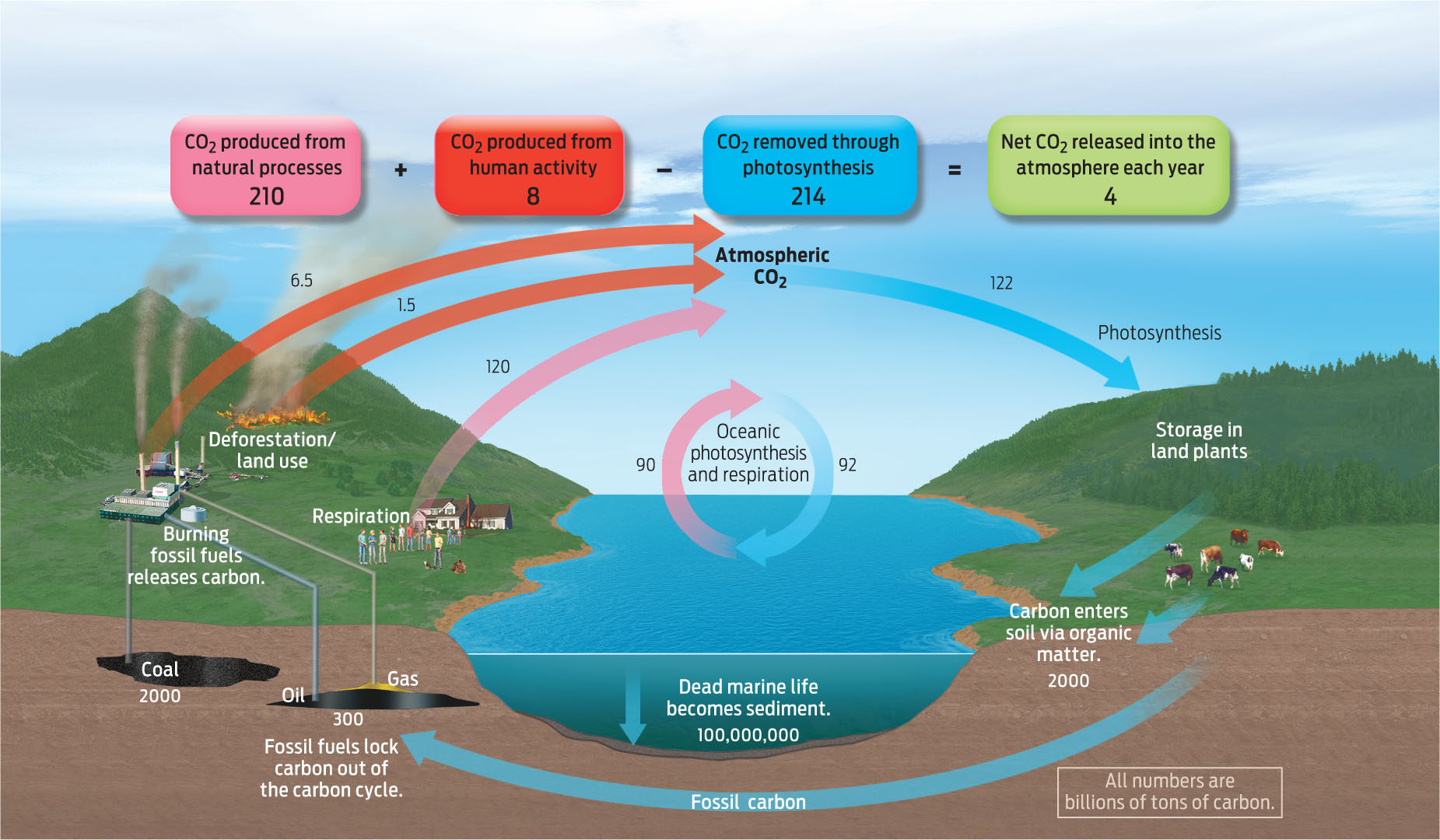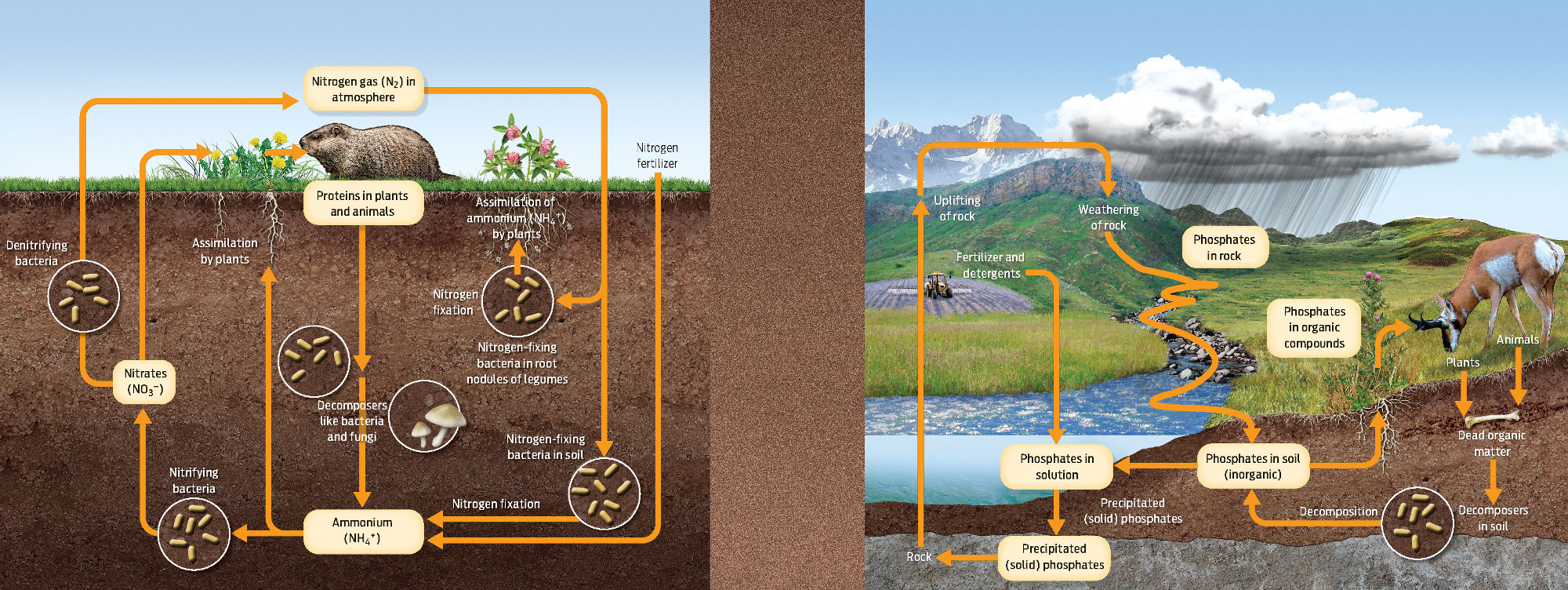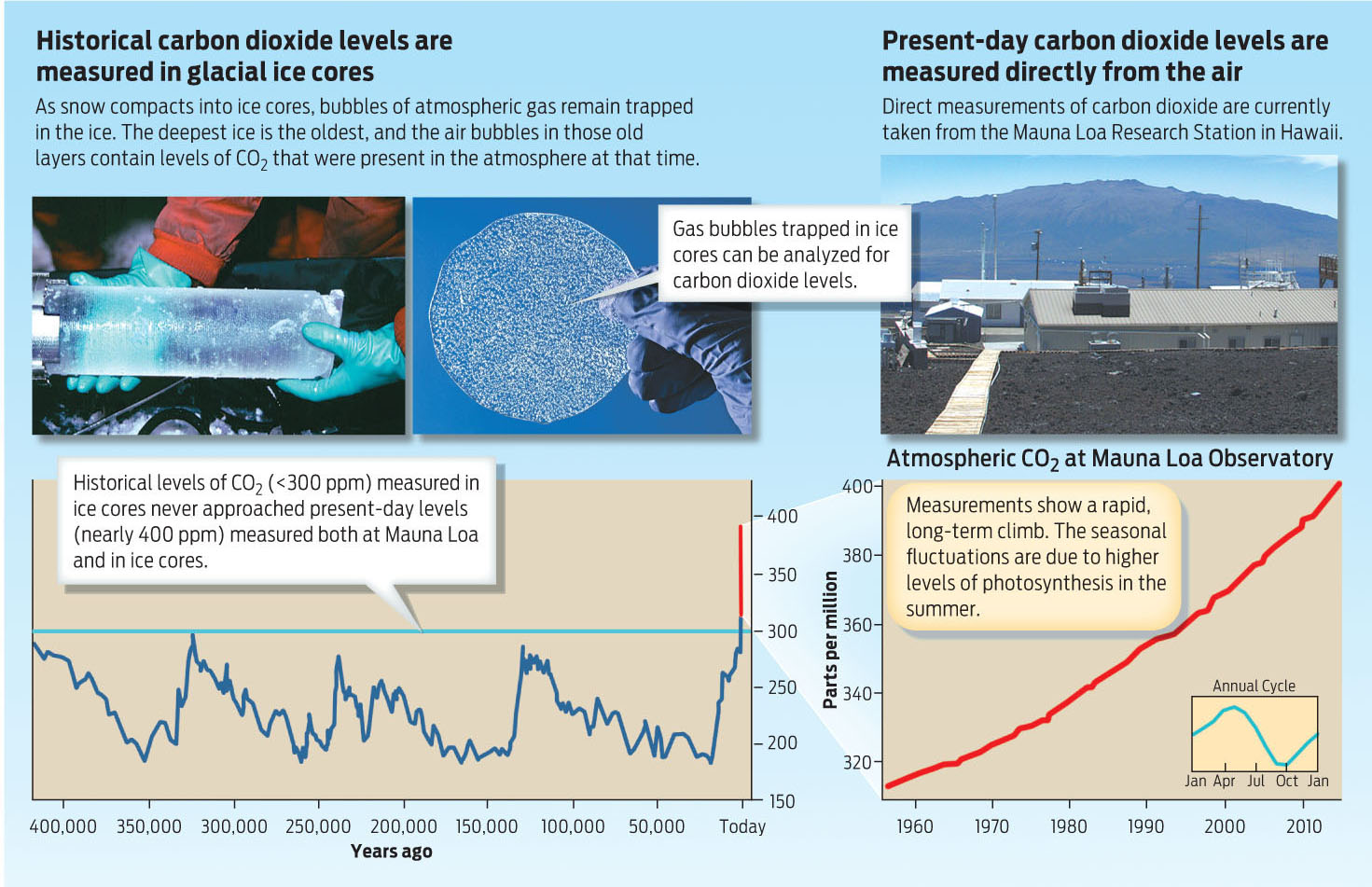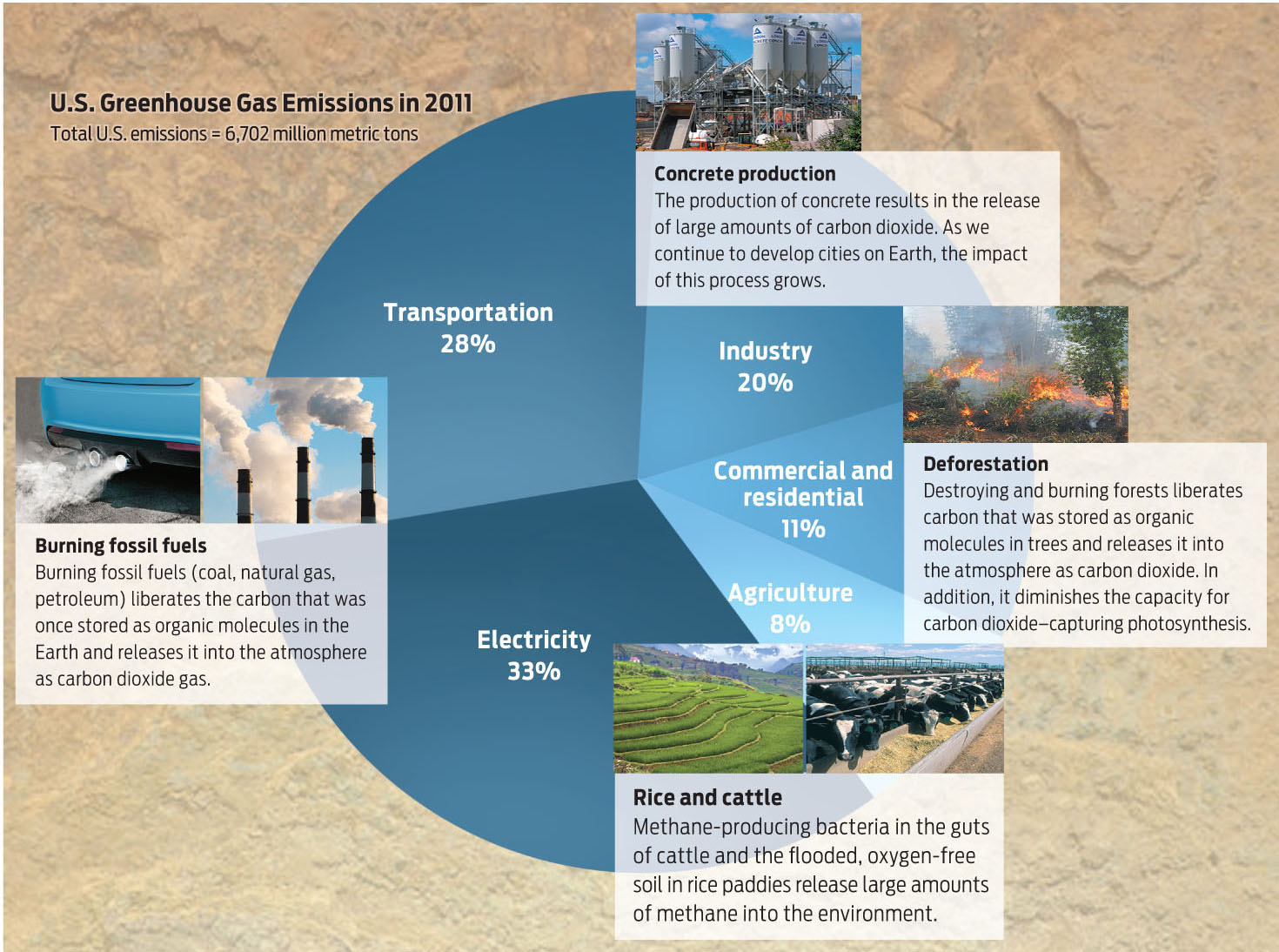FOLLOW THE CARBON
The immediate cause of this planetary warming is a fired-up greenhouse effect. And that, scientists argue, is the result of human activity. As a 2010 statement from the National Academy of Sciences puts it, “There is compelling, comprehensive, and consistent objective evidence that humans are changing the climate in ways that threaten our societies and the ecosystems on which we depend.” How did we get to be the culprits in this situation? In short, by pumping more carbon dioxide into the atmosphere.
FOSSIL FUEL A carbon-rich energy source, such as coal, petroleum, or natural gas, formed from the compressed, fossilized remains of once-living organisms.
Carbon dioxide is the most notorious player in the greenhouse effect, and scientists believe it is responsible for most of the warming. In fact, atmospheric carbon dioxide concentrations are higher now than they have been in more than 700,000 years.
CARBON CYCLE The movement of carbon atoms as they cycle between organic molecules and inorganic CO2
As discussed in Chapter 2, carbon is a natural ingredient in every living organism, part of the backbone of all organic molecules. Carbon also exists in inorganic forms: as carbon dioxide in the atmosphere, as carbonic acid dissolved in water, as calcium carbonate in limestone rocks. If dead organisms are fossilized before being digested by decomposers, the organic molecules contained within their bodies become trapped below Earth’s surface or under the seas. Over time, these compressed organic molecules become fossil fuels—coal, oil, and natural gas.
Like other chemical elements, the total amount of carbon on Earth remains essentially constant. In contrast to the way energy flows through an ecosystem in one direction (from the sun to producers to consumers and out to the universe as heat; see Chapter 22), elements such as carbon move in cycles. The movement of carbon through the environment follows a predictable pattern called the carbon cycle.
As it cycles through the environment, carbon moves between organic and inorganic forms. For example, animals take in organic carbon when they eat other organisms and release inorganic gaseous CO2 into the atmosphere as a by-product of cellular respiration. Similarly, when organisms die, decomposers in the soil use the dead organic material for food and energy, releasing some of the carbon during respiration as CO2.
Plants, photosynthetic bacteria, and algae take up CO2 during photosynthesis and convert it into organic sugar molecules, thus reducing atmospheric CO2 levels. Photosynthesis, respiration, and decomposition form a cycle that keeps carbon dioxide at a relatively stable level in the atmosphere. But human actions, like deforestation and burning fossil fuels, inject carbon dioxide that was not otherwise moving into the cycle (INFOGRAPHIC 23.9).
The carbon cycle involves the movement of carbon atoms as they cycle between organic molecules and inorganic CO2. Natural processes such as photosynthesis, respiration, and decomposition are responsible for most carbon cycling. Since the 1700s, human activities, including burning fossil fuels and deforestation, have made significant contributions to the carbon cycle, primarily by increasing the amount of carbon in the form of CO2 (measured in tons of carbon).

Carbon isn’t the only element that cycles through ecosystems. Other elements, such as nitrogen, phosphorus, and sulfur also follow natural cycles (see UP CLOSE: CHEMICAL CYCLES: NITROGEN AND PHOSPHORUS. But it’s the carbon cycle that is most relevant to the phenomenon of global warming.
UP CLOSE : CHEMICAL CYCLES: NITROGEN AND PHOSPHORUS

Phosphorus is critical for the structure of DNA, RNA, ATP, and phospholipids. It is also critical for bones and teeth. Phosphorus cycles primarily through soil, water, and organisms. It is not a major component of gases in the atmosphere. Phosphorus is generally added to an ecosystem by the weathering of rocks, although human activities can also add phosphorus compounds to soil and water. When taken up by organisms, it is incorporated into organic molecules, then released back to the environment by decomposition.
For most of human history, the amount of carbon present in the atmosphere as carbon dioxide has remained fairly constant. But since the 1800s, with the rise of industry and the invention of the internal combustion engine, humans have begun to alter the carbon cycle, adding increasing amounts of CO2 to the atmosphere.
Before the industrial revolution, the carbon trapped in fossil fuels was not easily accessible, and therefore it wasn’t cycling as part of the carbon cycle. But modern drilling and mining methods have unlocked the deep reserves of this ancient planetary energy. The CO2 released when humans burn fossil fuels is the largest source of the carbon being added to the atmosphere by humans and is a major contributor to the enhanced greenhouse effect.
How do scientists know that carbon dioxide levels are much higher now than in the past? There are two main sources of evidence. Air bubbles trapped in glacial ice from Greenland and Antarctica provide a historical measure of carbon dioxide in the atmosphere. Ice cores drilled at these sites provide data on very long term changes in CO2 levels (and temperature), going back hundreds of thousands of years. These data show, for example, that levels of CO2 have cycled in patterns that correlate with major ice ages. Since 1958, scientists have also directly measured CO2 in the atmosphere—for example, at the Mauna Loa Research Station, which sits atop an inactive volcano in Hawaii. When combined, these two types of data show that atmospheric CO2 has been rising steadily since the industrial revolution—increasing from about 280 parts per million (ppm) in 1800 to nearly 400 ppm in 2013—or more than 40% (INFOGRAPHIC 23.10).
Examining data from ancient air bubbles and present-day air measurements, scientists have recorded an approximately 40% increase in atmosphere CO2 levels since 1800.

CARBON FOOTPRINT A measure of the total greenhouse gases produced by human activities.
Activities that decrease the number of photosynthetic organisms also increase global CO2 levels. Since photosynthesizers are the only consumers of carbon dioxide in the carbon cycle, removing them not only reduces the amount of carbon dioxide they might have consumed, but also—in the case of large trees and stable populations of algae—eliminates what are in essence long-term storage vessels of carbon. Human activities that reduce the number of photosynthetic organisms on the planet include large-scale slash-and-burn agriculture, development that leads to deforestation, and various forms of pollution. Together, these activities contribute to our carbon footprint, a subset of our total ecological footprint, which is discussed in Chapter 24.
Though CO2 is the major player in global warming, another important greenhouse gas is methane (CH4). Methane is produced by natural processes, such as the decomposition of organic material in swamps by microbes. However, agriculture, including cattle farming and growing rice in paddies, now accounts for more than half the total methane being pumped into the atmosphere. One of the main sources of methane is the gas produced by archaea that live in the digestive systems of cattle. Emitted as flatulence, it adds an estimated 100 million tons of methane a year to the atmosphere. Although the atmospheric concentration of methane is far less than that of CO2, methane is particularly worrisome because it is 30 times more potent than CO2 as a greenhouse gas.
With this steep rise in greenhouse gases have come steadily rising temperatures around the globe, with most of that warming occurring since the 1970s. Virtually all climate scientists agree that greenhouse gases emitted by human activities—primarily driving gasoline-powered cars and burning coal to generate electricity—have caused most of the global rise in temperature observed since the mid-20th century. In 2007, the Intergovernmental Panel on Climate Change, comprised of hundreds of scientists from around the world, concluded that the global rise in average yearly temperature since the mid-20th century was “very likely” anthropogenic—that is, caused by humans. (In statistics, “very likely” means a certainty of greater than 90%.) (INFOGRAPHIC 23.11).
A variety of human activities are increasing the levels of greenhouse gases in the atmosphere. Power generation and transportation account for the largest proportion of greenhouse gas emission.
